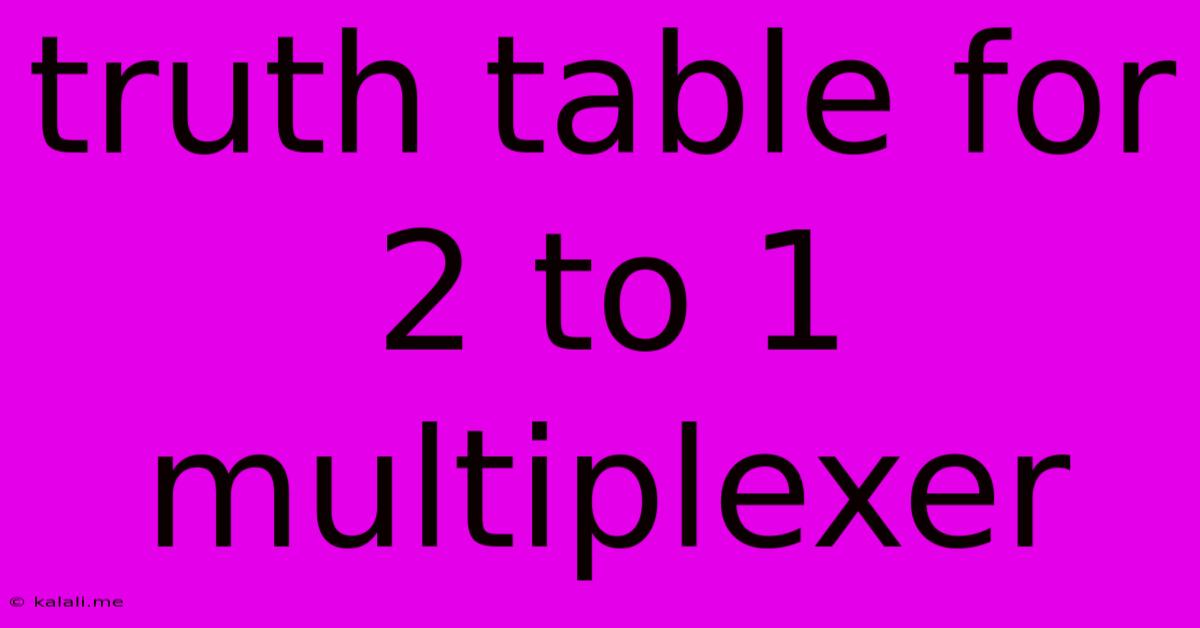Truth Table For 2 To 1 Multiplexer
Kalali
Jun 06, 2025 · 3 min read

Table of Contents
Truth Table for a 2-to-1 Multiplexer: A Comprehensive Guide
Understanding the truth table for a 2-to-1 multiplexer is crucial for anyone working with digital logic circuits. This article will provide a clear explanation of the 2-to-1 mux, its functionality, and how to construct and interpret its truth table. We'll also explore its applications and delve into related concepts.
A 2-to-1 multiplexer (MUX), also known as a data selector, is a combinational logic circuit that selects one of two input signals and forwards it to a single output line. The selection is controlled by a select line (often denoted as 'S'). This makes it a fundamental building block in digital systems, used in various applications from data routing to data compression.
Understanding the Components
The 2-to-1 multiplexer has three inputs:
- I<sub>0</sub> and I<sub>1</sub>: These are the two input data lines.
- S: This is the select line. It determines which input will be passed to the output.
And one output:
- Y: This is the output line, carrying the selected input signal.
Constructing the Truth Table
The truth table systematically lists all possible combinations of input values and their corresponding output values. For a 2-to-1 multiplexer, we have two input lines (I<sub>0</sub> and I<sub>1</sub>) and one select line (S). Therefore, there are 2<sup>2</sup> = 4 possible input combinations.
| S | I<sub>1</sub> | I<sub>0</sub> | Y |
|---|---|---|---|
| 0 | 0 | 0 | 0 |
| 0 | 0 | 1 | 1 |
| 1 | 0 | 0 | 0 |
| 1 | 1 | 0 | 1 |
| 1 | 1 | 1 | 1 |
| 0 | 1 | 0 | 0 |
| 0 | 1 | 1 | 1 |
Explanation:
- When S = 0, the output Y is equal to the input I<sub>0</sub>. Regardless of the value of I<sub>1</sub>, the output reflects I<sub>0</sub>.
- When S = 1, the output Y is equal to the input I<sub>1</sub>. The value of I<sub>0</sub> is ignored.
This behavior is precisely what makes the multiplexer a data selector – it chooses one input based on the select line's value.
Boolean Expression
The functionality of the 2-to-1 multiplexer can also be represented using a Boolean expression:
Y = S.I<sub>1</sub> + S'.I<sub>0</sub>
Where:
.represents the AND operation.+represents the OR operation.'represents the NOT operation (inversion).
This equation clearly shows how the output (Y) is determined by the select line (S) and the input lines (I<sub>0</sub> and I<sub>1</sub>).
Applications of 2-to-1 Multiplexers
2-to-1 multiplexers are fundamental components used in a wide range of applications, including:
- Data selection: Choosing between different data sources.
- Data routing: Directing data to different destinations.
- Function generation: Implementing complex logic functions.
- Digital signal processing: Used in various digital signal processing algorithms.
- Building larger multiplexers: Cascading 2-to-1 multiplexers allows the creation of larger multiplexers with more inputs.
Understanding the truth table and the Boolean expression of a 2-to-1 multiplexer is essential for designing and analyzing digital circuits. It's a foundational concept with wide-ranging applications in the world of digital electronics. This understanding builds a strong base for tackling more complex digital logic designs and systems.
Latest Posts
Latest Posts
-
What Does The J In Ssj Mean
Jun 07, 2025
-
Car Wont Start One Click Then Nothing
Jun 07, 2025
-
Him Domt Know Where Him Is
Jun 07, 2025
-
Get Your First Image In Knowledge Panel
Jun 07, 2025
-
Has Jennifer Aniston Ever Gone Nude
Jun 07, 2025
Related Post
Thank you for visiting our website which covers about Truth Table For 2 To 1 Multiplexer . We hope the information provided has been useful to you. Feel free to contact us if you have any questions or need further assistance. See you next time and don't miss to bookmark.